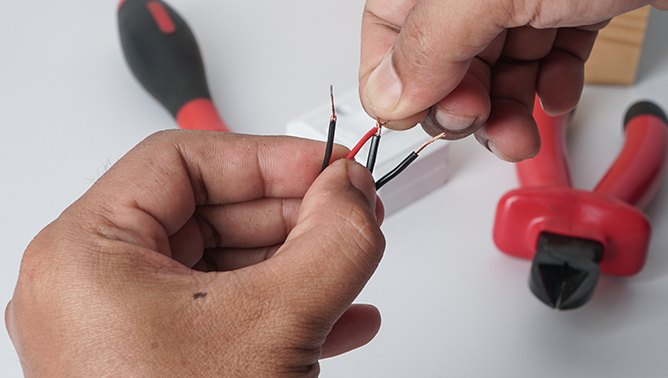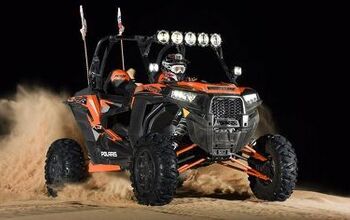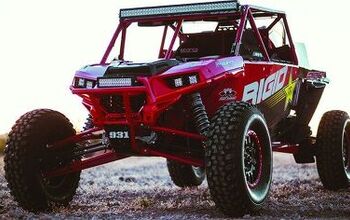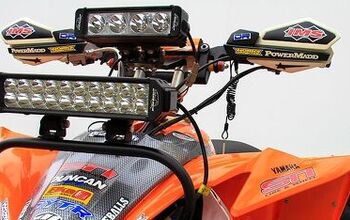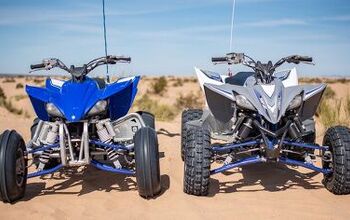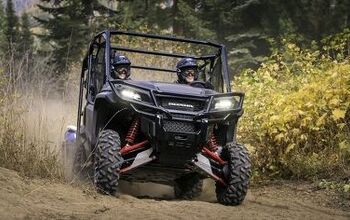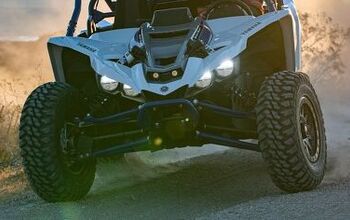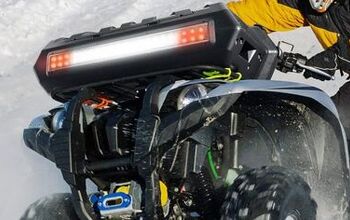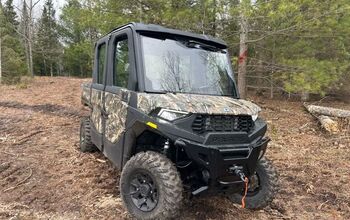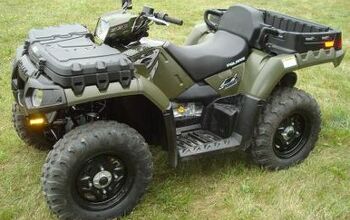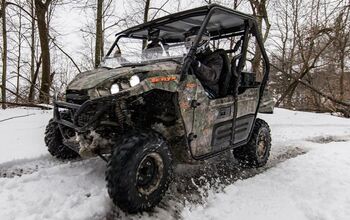Basic Wiring Tips for ATVs and UTVs
Make wiring your new ATV and UTV accessories a cinch when you follow these tips
Protect your machine and your power-drawing accessories
Before wiring in new ATV or UTV accessories, you need to know how much of a power draw they will be and how much your machine can handle.
For many of us, after we buy that brand new (or at least new to us) Side-by-Side or ATV, we immediately start thinking about accessorizing it. We might pick up some awesome and helpful products, like a strong winch, radio, and huge LED light bar. While shopping for new off-road goodies is exciting, you need to first look at just how much power drain your electrical system handle.
Most off-road vehicles have a small reserve of power when being fully taxed electrically. This is for accessories and you must know what the percentage of available power is in order to prevent electrical problems. The stator is like the alternator on your car and runs off the crankshaft of most ATV/UTV engines.
To help you along your way, we’ve come up with a list of things to really pay attention to when wiring in ATV electrical accessories.
Lead photo courtesy Erlyani999/Shutterstock
Table of Contents
-
1. Buy Before Anything Else: Service Manual: Shop Now
-
2. Editor's Choice: Power Distribution Hubs: Shop Now
-
3. Proper Wire Sizing: Flexible Copper Low Voltage Primary Wire: Shop Now
-
4. Best Electronic Switches: Quality Rockers or Gang Switch Panels : Shop Now
-
5. High Quality Connectors: Waterproof Electrical Connector Kit: Shop Now
-
6. Best Wire Shielding and Securing: : Shop Now
1. Buy Before Anything Else: Service Manual
Before you do any kind of work on your ATV or UTV, the most important tool you should have in your hand is a service manual. We really like the OEM manual when you can get your hands on one, but Clymer is an aftermarket brand that does a pretty darn good job of providing specs and walking you through repair processes.
Why are we suggesting you get one before installing accessories into your ATV wiring? The manual will have critical information like how much power your ATV or UTV is capable of putting out, so you know just how many or how powerful the products you install can be. This one detail could mean the difference between a good working machine and new accessory or possibly the destruction of both.
2. Editor's Choice: Power Distribution Hubs
If you think you will be adding several electrical accessories, our number one suggestion is to to install a power block or hub. This gives you an all-in-one location that provides fused power distribution and ground locations in one convenient location. These power blocks or hubs are available with a wide number of terminal connections to cover any number of electrical accessories you want to add to your ATV wiring system. These style hubs are not water-tight, but they don't really have to be as long as the terminals are covered.
3. Proper Wire Sizing: Flexible Copper Low Voltage Primary Wire
If you take the time to read the installation instructions of the accessories you're wanting to wire into your ATVs electrical system, most will provide a recommendation for wire size and length to use. For example, if you're doing an ATV light bar install and it calls for 14 gauge wire to be used and you only use 16 gauge because it's all you have. If you use that smaller gauge wire, it may not be capable of handling the amperage draw and get hot. This could potentially lead to the wire shielding starting to melt away leaving exposed wires and possible electrical shorts. Yeah, we're talking about extreme situations here, but they're totally possible
There are plenty of kits that offer a wide variety of wire sizes and colors for you to keep in your shop, and be sure to get the stuff that is flexible so you can wire it around your frame and other components.
4. Best Electronic Switches: Quality Rockers or Gang Switch Panels
Having a good switch can make or break your ATV wiring job. Rocker switches are available in a variety of sizes and styles, the only thing that holds you back from the number of accessories you do with your ATV wiring is switch space. If you're run power directly from the fuse block, through the switch and directly to your electrical accessory, you need to make sure that it's capable of handling the amperage load, much like choosing the right wire size. For really heavy loads, you can run your accessory off of a relay that is activated by a rocker switch, which is a preferred way of getting the job done but requires more space and wire to mount the relay in a safe location.
A newer, cleaner and much more convenient way of switching multiple electrical accessories can be done by using a gang switch. These are similar to the power block previously mentioned, but taken to the next level of cool. Most kits come with a heavy duty fuse or circuit breaker that you wire in between the battery and the control box. The control boxes come in numerous fused outlets that you wire your accessories to and are controlled by a small remote panel that is easily mounted on UTV dash panels or even a fender panel on an ATV.
5. High Quality Connectors: Waterproof Electrical Connector Kit
When you have to terminate or crimp on connectors to your ATV wiring, you want to make sure that you're going to be using high quality, waterproof connectors. If you've never done any kind of electrical wiring before and don't know the first thing about crimping wires, take some time to watch some videos on YouTube. You'd be surprised that there are much more than funny dog, cat and human trick videos on there. Having a good crimp can mean the difference between wires breaking loose and shorting out or staying where you need them to be.
If you have broken wires that need to be spliced back together, life has recently gotten much easier. If you're like some of our staff trying to use a solder gun to get wires back together, you can be left with a big ball of melted solder and a few strands of wire touching each other. There are some new solder seal wire connectors that not only solder the wires together with heat from a heat gun, but they also feature heat shrink tubing that seals off the ends from the elements. These are a must have in any DIY mechanics tool box.
6. Best Wire Shielding and Securing:
One of the most common mistakes or issues we see when adding 12 accessories to your ATV wiring, is that the wires are either not shielded or secured in place. While you may not have any issues with sloppy wiring, why take a chance? If you are going to add an expensive product like a light bar to your machine, why not take time to route the wires in the best possible way. Buying some wire shielding or loom to cover the mass of wires will not only keep the wires together and looking nice, but it prevents chaffing, which could lead to shorts and all kinds of other problems. Also, don't be afraid to use a good handful of zip ties to secure the shielded or un shielded wires into place. The tighter you can keep the wires to your factory wiring loom or frame, the less chance there is for anything to protrude up from the ground and yank it apart.
Remember to read the directions for the electrical requirements for the product you are installing. Accessories like your winch require specific placement of the relay and some HID lights will not work without a good supply of power. We have had brand new lights flicker and never work again only to figure out later that the low voltage present burnt out an igniter or other part in the system.
How do I choose the right power hub?
With so many options, it can come down to price and convenience. Unless you've already bought switches and switch panels, the best and easiest solution for power distribution to your accessories, is to use one of the gang switch options we discussed. These really take care of everything you need in one simple package. If you want to use traditional rocker switches, you'll want to get a power hub that has a few more terminals than you need at the moment. This gives you the option of running additional accessories down the line. Some provide both power and ground terminals, but you can also get a hub that only has fused power in the event you just want to ground your accessory close by.
With so many different switch types, how do I know which to choose?
It really comes down to appearance and personal preference. You can go with some switches that are as small as a button, but the most common are the automotive style rocker switches. Many of these are pre-printed with common accessory images on them or you can even have custom ones made. The main thing you need to know is how much amperage that they can withstand if you're not going to be using a relay to power your higher draw accessories.
Additional Resources
Become an ATV.com insider. Get the latest news first by subscribing to our newsletter here.
We are committed to finding, researching, and recommending the best products. We earn commissions from purchases you make using the retail links in our product reviews. Learn more about how this works.
Updated 8/11/2021: Ranked product, added links to multiple products in each listing, added FAQ, added additional resources, updated product images
Whether he is in Mexico covering the Baja 1000, building ATVs for local racers, or out enjoying the trails, Rick’s passion shows in his stories. Learning to wrench his own machines from his grandfather, Rick also has an undying appreciation for the mechanics of off-road vehicles. Do not let the dirt and mud fool you, though, as Rick also has a deep love for street cars.
More by Rick Sosebee



